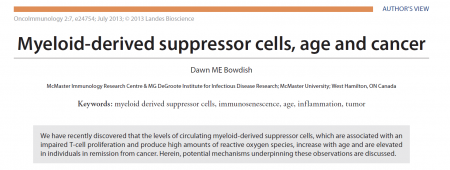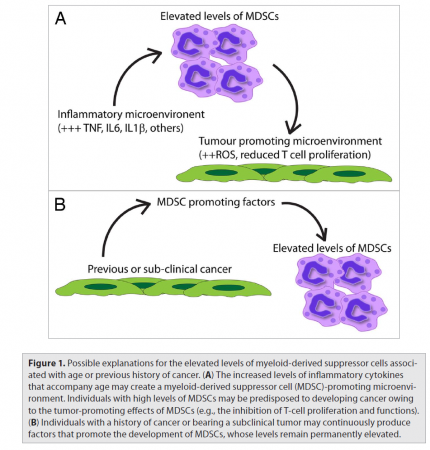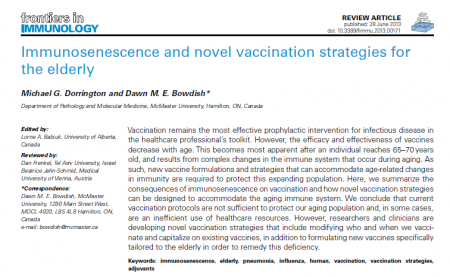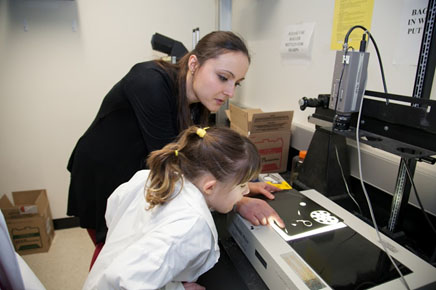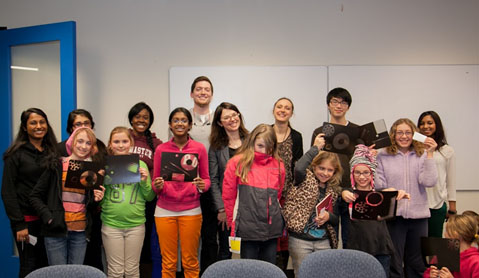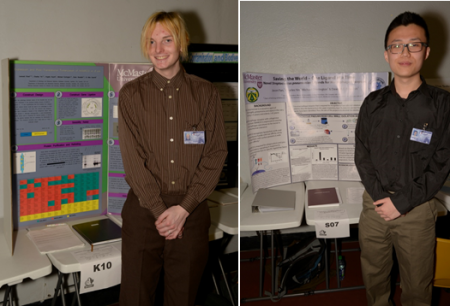Bowdish lab associate member (technically she’s supervised by Dr. Mike Surette but we think of her as one of our own), Julie Kaiser, successfully defended her MSc thesis “Host responses to the Strepotococcus Milleri Group”. To see a photo of Julie in her post exam bliss/haze click here. Julie is moving on to a PhD at UWO in Dr. Dave Heinrichs lab. We’re sending Dave on of our best & brightest – we expect a thank you card any day now.
Category Archives: News
The Bowdish lab enters a collaborative agreement with Qu Biologics.
The lab of Dr. Dawn Bowdish at the McMaster University Immunology Research Centre (MIRC) has recently begun collaboration with the Vancouver-based pharmaceutical company Qu Biologics on preclinical studies investigating the role of macrophage dysfunction in chronic inflammation.
Qu Biologics has developed Site Specific Immunomodulators (SSIs), which aim to “reboot” the body’s innate immune system in targeted organs or tissues to reverse chronic inflammation.
“Macrophages are important cells of the innate immune system. There is growing evidence that macrophage dysfunction underlies many important common chronic diseases, including cancer and autoimmune disease,” said Dr. Hal Gunn, CEO of Qu Biologics. “This collaboration will be invaluable to assist in our understanding of the benefits of SSI therapy on macrophage function as it relates to chronic inflammation and immune dysfunction.” Dr. Gunn added.
The studies will test whether a lung-specific SSI therapy can restore normal lung and bone marrow-derived macrophage function using a variety of in vivo and in vitro assays.
Dr. Bowdish adds “This is an ambitious and exciting project that takes a fundamentally different approach to tackling the problem of chronic inflammation, which has been very resistant to therapeutic intervention. My team is thrilled to be working together on a problem that affects the lives of so many Canadians.” This work capitalizes on the resources and immunology expertise of the McMaster Immunology Research Centre and Dr. Bowdish’s research interests in how inflammation impairs macrophage function.
About Qu Biologics
Qu Biologics develops Site Specific Immunomodulators (SSI), a novel class of immunotherapies that aim to reboot the body’s immune system. SSIs are designed to stimulate an immune response in targeted organs or tissues to potentially reverse the chronic inflammation underlying many conditions including cancer and autoimmune disease. The company recently launched a Phase 1/2 clinical trial to research SSI therapy for the treatment of Crohn’s disease.
Backed by a prestigious group of scientific advisors and board members, Qu Biologics is led by a management team that includes co-founder and CEO Dr. Hal Gunn, a physician and expert on the body’s immune response to chronic disease; and Chief Medical Officer Dr. Simon Sutcliffe, former CEO of the BC Cancer Agency and a distinguished clinician, scientist and leader in cancer control in Canada and internationally. For more information, visit www.qubiologics.com and www.qucrohnstrial.com.
For more details and to see the original press release here:
Alumnus update: Former Bowdish lab undergraduate, Keith Lee, receives a CIHR MSC scholarship!
Keith Lee, who will be attending the University of Toronto for medical school starting August 2013 has received a very prestigious CIHR MSc graduate award. He has chosen to decline to pursue his medical studies and potentially re-apply as an MD/PhD student next year. Congratulations Keith!
“Myeloid-Derived Suppressor Cells, Age & Cancer” 2013. Oncoimmunology.
Dr. Bowdish discusses the implication of our Verschoor et al publication “Blood CD33(+)HLA-DR(-) myeloid-derived suppressor cells are increased with age and a history of cancer.” in studies of aging and cancer in the below commentary.
Click image for .pdf.
This is an open access publication so please feel free to use the following image in presentations/publications providing that it is properly referenced.
Collaborator update: Fan Fei wins “Glasgow Polyomics & University of Strathclyde Young Scientist Award” at the 9th Annual Conference of the Metabolomics Society!
Fan Fei (PhD candidate), under the supervision of Dr. Brian McCarry, and in conjunction with Bowdish lab undergraduate Keith Lee, studies age related changes in the inflammatory response from a metabolomics perspective. Funded by the Russell Bell Travel Scholarship award, she attended the 9th Annual conference of the Metabolomics Society. July 1-4, 2013, SECC Glasgow. She won the “Glasgow Polyomics & University of Strathclyde Young Scientist Award” for outstanding poster presentation of research in the field of metabolomics at the Metabolomic Conference 2013 in Glasgow Scotland for her work “Comprehensive Metabolomic Analysis Reveals Major Differences in the Macrophage Inflammatory Response Between Young and Aged Mice”. Way to go Fan!
“Immunosenescence & novel vaccination strategies for the elderly” 2013. Dorrington et al. Frontiers in Immunology
What is the best way to reduce infectious disease in the elderly? Vaccination! Unfortunately the aging immune system presents a number of challenges for vaccine development. Bowdish lab PhD candidate Mike Dorrington discusses them in this review and presents a case for developing novel vaccines that work within the constraints of the aging immune system.
Media coverage: This paper was picked up by MDLinx. See their coverage here.
Click image for .pdf.
PhD candidates Alicja Puchta and Mike Dorrington win at the 2013 FHS Research Plenary
Congratulations to both Alicja Puchta and Mike Dorrington for winning at the 2013 FHS research Plenary! Mike was the recipient of the Best Poster Presented by a Doctoral Candidate award. Alicja was the recipient of an Outstanding Achievement Award, which recognizes graduate students in their final year of a Master’s or Doctoral program who have made outstanding achievements, based on the opinion of their graduate program. This award can be given to a maximum of 10-15% of all students in the final year of a Master’s or Doctoral program affiliated with the Faculty of Health Sciences.
Congratulations and keep up the awesome work!
“Blood CD33+HLA-DR- myeloid-derived suppressor cells are increased with age and a history of cancer” 2013. Verschoor et al. JLB
MDSCs (myeloid derived suppressor cells) are a recently discovered and very heterogenous cell type that appear to directly suppress T cell responses and their presence in the tumour or the circulation is an extremely poor prognostic marker.
The Bowdish lab recently dipped our foot into the confusing world of MDSCs because we were curious to know whether their frequency increases with age and if so, could this explain why age is a risk factor for many cancers. They do increase with age and this may explain why some adaptive immune responses decline with age. One thing we were very surprised to find is that individuals who had any history of cancer but were believed to be in remission had higher levels of these cells in circulation. This begs the question – did these people have higher levels and to begin with and is this why they were predisposed to cancer? Or do they still have subclinical tumours that promote the development of MDSCs? Or does the suppressive environment of the cancer microenvironment stay with you for life? More studies (not by us, that was enough) are warranted.
For the .pdf click here
For the supplementary data, click here.
Bowdish Lab Hosts Future Female Scientists (Canadian Association of Girls in Science).
On Thursday March 7th, the Bowdish Lab welcomed a group of five to twelve year old girls for a night for a night of science fun! In association with The Canadian Association for Girls In Science (CAGIS), the Bowdish lab opened its doors to promote and encourage our future young scientists.
CAGIS is an award winning national science club for girls aged 7-16, the purpose of which is to promote, educate and support interest and confidence in science, technology, engineering and mathematics among girls. Needless to say, The Bowdish Lab jumped at an opportunity to inspire such an eager group.
The night began with an introductory presentation by Dr. Bowdish which introduced the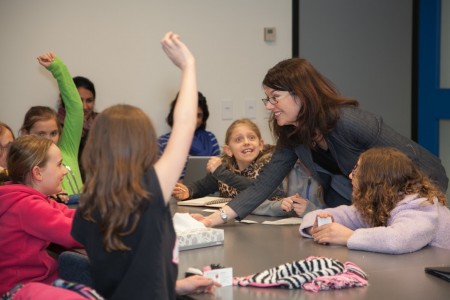 girls to basic concepts of immunology, good and bad germs and the members of the Bowdish Lab. Dr. Bowdish proposed a challenge to the girls; to encourage scientific inquiry, whoever asks the greatest number of scientific questions by the end of the night will win a prize! Every time a student asked a question, they would receive an official Dr. Dawn Bowdish business card to keep track. Dr. Bowdish nearly ran out of business cards
girls to basic concepts of immunology, good and bad germs and the members of the Bowdish Lab. Dr. Bowdish proposed a challenge to the girls; to encourage scientific inquiry, whoever asks the greatest number of scientific questions by the end of the night will win a prize! Every time a student asked a question, they would receive an official Dr. Dawn Bowdish business card to keep track. Dr. Bowdish nearly ran out of business cards 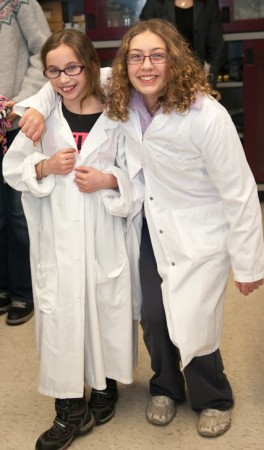 before the end of the presentation!
before the end of the presentation!
The girls were then split into groups of two to three to take part in a variety of hands-on scientific activities. Of course, if the girls wanted to participate in awesome science activities, they need the proper scientific attire.
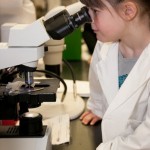
Members of the Bowdish lab organized five stations to help explain what we do as scientists. . Mike Dorrington introduced the girls to using a microscope to analyze anything from blood to nasal wash samples. Mike showed the girls how we separate blood into different components in order to isolate white blood cells. The girls were then able to observe the various types of white blood cells using pre-prepared slides. Bowdish lab organized five stations to help explain what we do as
Alicja Puchta demonstrated how scientists develop special film to analyze anything from X-ray results to protein analysis. The girls were taken into a totally different world – the dark room. Special red lights allow for scientists to avoid exposing sensitive film to normal light. The girls were able to expose film to a variety of objects such as CD’s and pens and develop the film for their own take-home souvenir!
Avee Naidoo and Keith Lee introduced the concepts of acid and base chemistry using a red-cabbage based pH indicator. The girls were allowed to use common household products to visualize changes in pH. Acids like vinegar turned the purple solution a bright neon pink, whereas bases such as baking soda turned the solution to blue and green. The grand finale was to add a piece of dry ice into a (green) basic solution. What would happen? The dry ice was able to turn the solution a variety of colors from green to blue to purple to pink in an eye catching manner.
red-cabbage based pH indicator. The girls were allowed to use common household products to visualize changes in pH. Acids like vinegar turned the purple solution a bright neon pink, whereas bases such as baking soda turned the solution to blue and green. The grand finale was to add a piece of dry ice into a (green) basic solution. What would happen? The dry ice was able to turn the solution a variety of colors from green to blue to purple to pink in an eye catching manner.
Kyle Novakowski explained the concepts of dry ice and how we as scientists rely on it to send samples around the world while keeping them very cold. Students were shown what happens when dry ice is added to warm water and the process of sublimation. The resulting CO2 gas was then bubbled through a soapy solution to make spooky “boo bubbles” which the girls were able to hold in their very own hands. The girls were very excited to pop the bubbles and witness the escaping gas.
Although the girls did not wish to be whisked away from the exciting applic

ation s of dry ice, Dr. Preethi Jayanth was able to maintain the same level of fun at her stations. Our future scientist guests were able to observe various types of agar used to grow
After a few hours of exciting science, our champion question-asker was awarded a prize during a wrap-up Q&A session with Dr. Bowdish and the lab members. The immense amount of positive feedback and enthusiasm made for a wonderful night that we hope to experience again soon.bacteria. While peach and chocolate agar may sound appetizing – nobody would want to eat this stuff! The girls were given the opportunity to detect microbes on their own hands before and after washing! Two to three days later, the girls were sent pictures of all the bacteria on their hands which had grown on the agar.
Bowdish Lab Cleans Up at the 53rd Annual Bay Area Science and Engineering Fair (BASEF)!
On Thursday May 21st, Bowdish Lab members were not only working hard as judges at the 53rd Annual BASEF fair, but also actively participating in presenting our research. Our high school students Jason Fan, winner of the IIDR summer studentship in 2012, and Leonard Rivet, a high school co-op student, both created fantastic posters and engaged judges in discussing their projects. Jason Fan (Right) received a Gold Merit Award and $100 for his poster entitled “Saving the World — One Ligand at a Time: Novel Streptococcus pneumoniae Ligands for Macrophage Receptors”. Leonard Rivet (Left) received a Silver Merit Award and $80 for his poster entitled “Expression and Post-Translational Trimerization of MARCO in E.coli”.
Jason went on to win a silver award at the Canada wide Science Fair and to be accepted to McMaster’s prestigious Bachelor of Health Sciences program.
Congratulations to both our fantastic young scientists!


